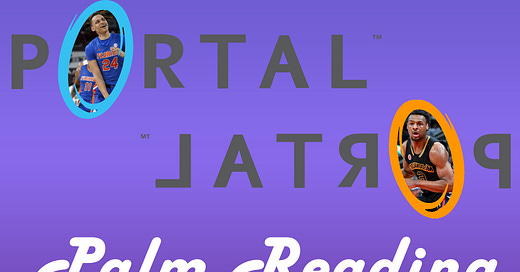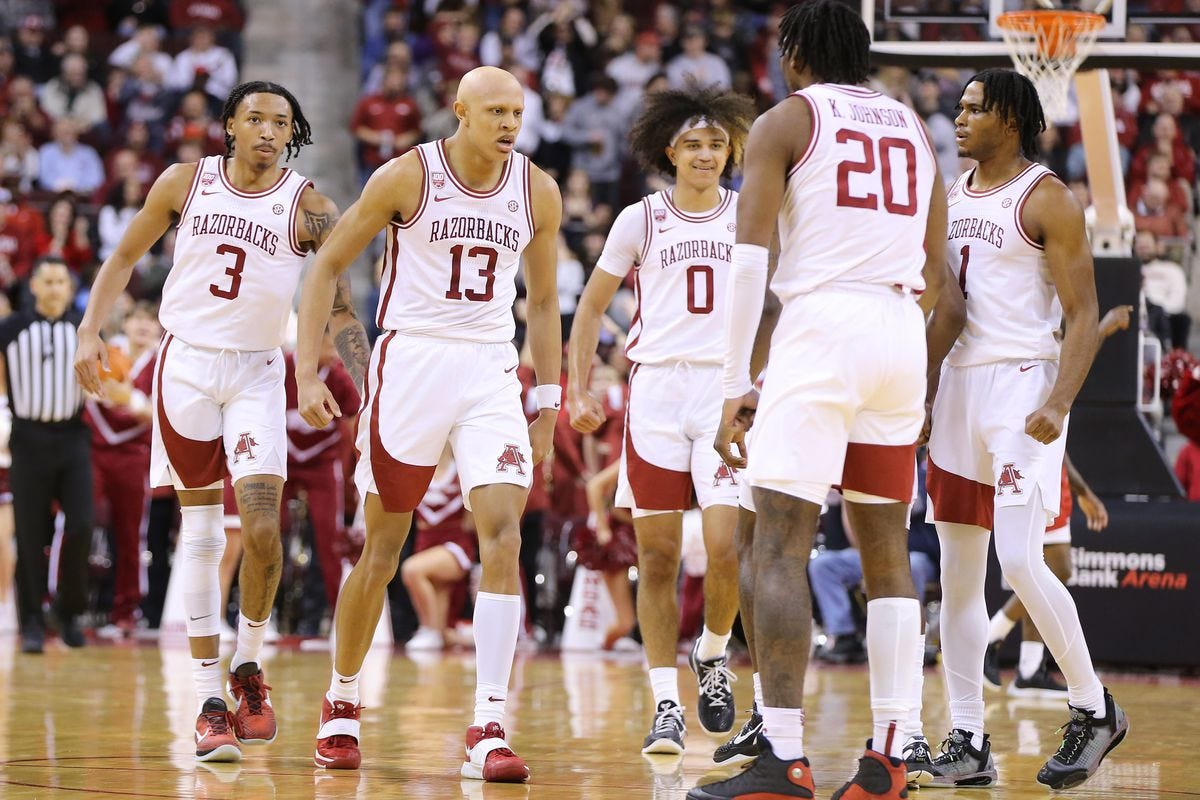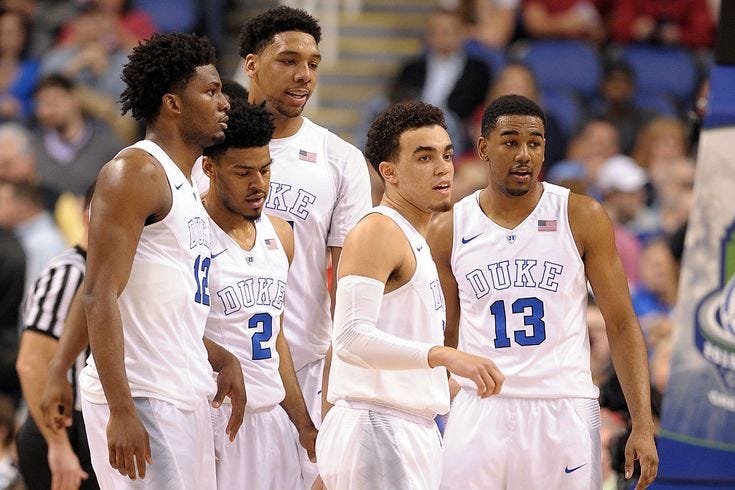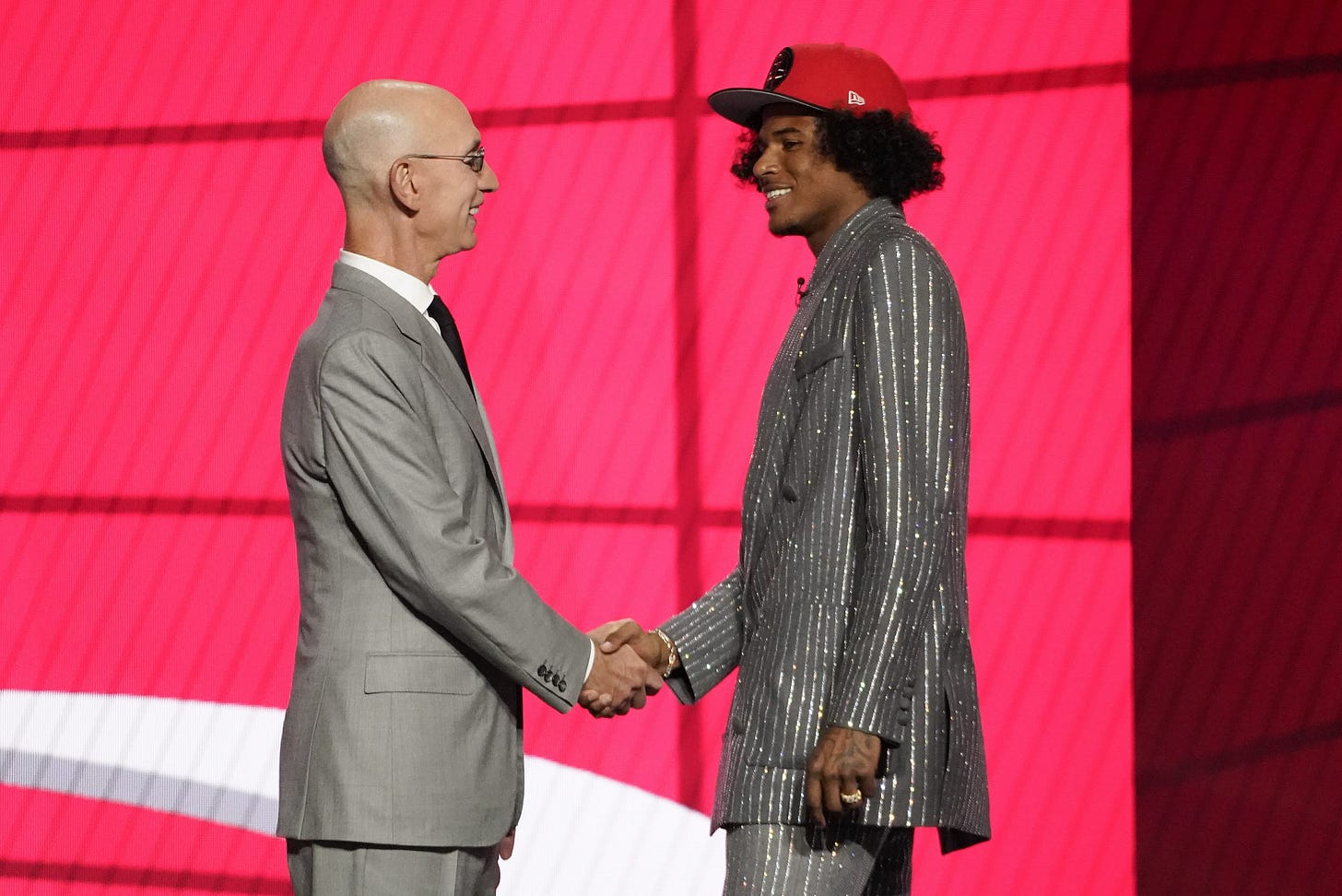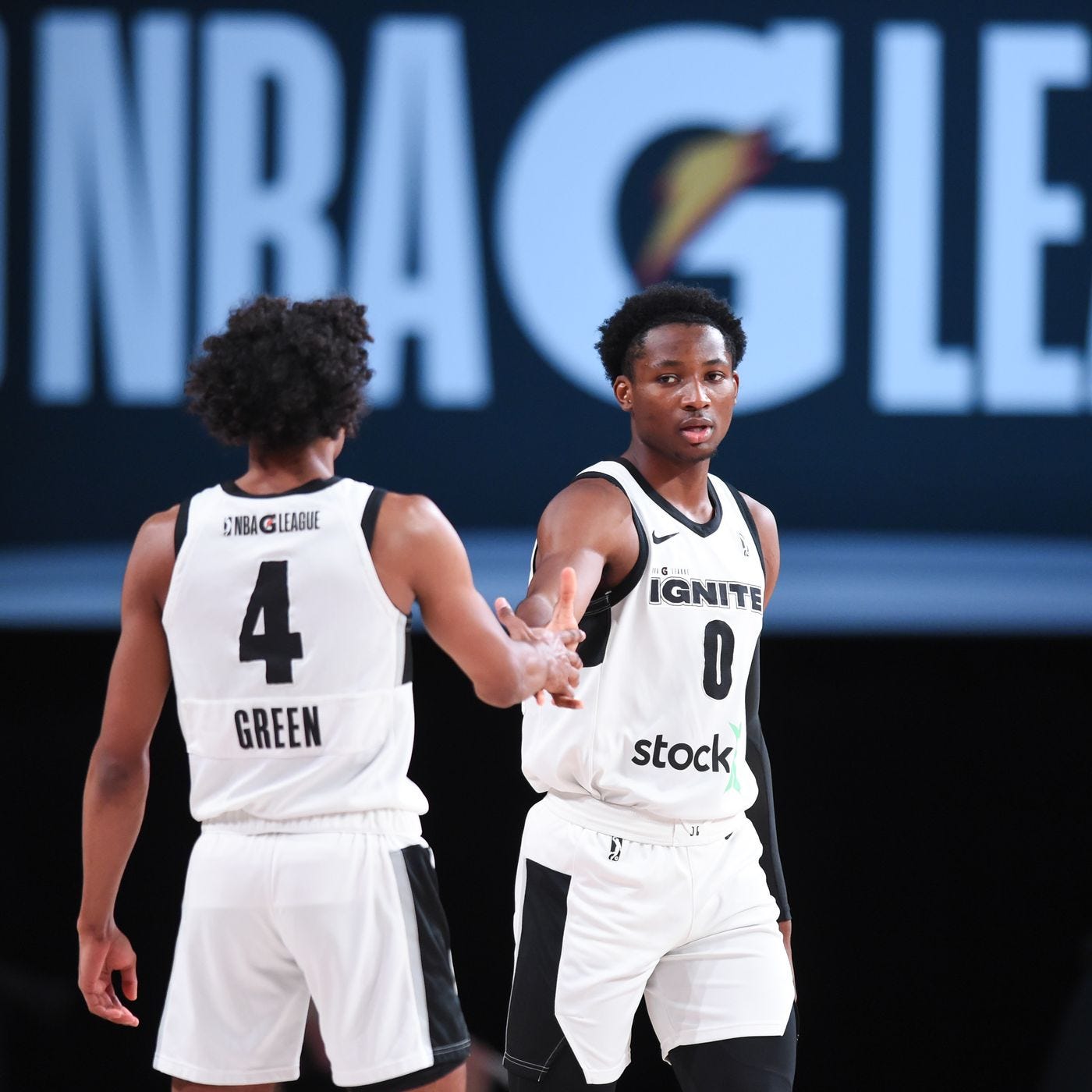Palm Reading: Embracing the Portal Coil
The Transfer Portal is here to stay and has changed college basketball forever. Should it change who and how I scout for the NBA Draft?
Merriam Webster:
Portal: door, entrance, especially: a grand or imposing one
There’s long been a method to the madness and an order to the progression of players through the ranks of basketball. One starts in high school, plays in college, then plays professionally at the NBA level. Of course, nothing is ever that cut and dry: programs like Overtime Elite and the G-League Ignite have emerged, while overseas opportunities are often not treated as serious ventures or milestones compared to making the NBA.
Thus, whenever there is a big rock dropped into the pond, the ripple effects are multiple: thunderous at first, too wide to see, until the later ripples have reached their far-off conclusions. Right now, we’re somewhere in the middle of the ripples surrounding the addition of the transfer portal to the NCAA tier of the basketball progression path.
It’s important to mention that the passage of NIL laws permitting players to get to cash in on their own rights finally came at the same time as the advent of the transfer portal. It’s hard to imagine one without the other, as often players will move due to a lucrative NIL deal offered at one school over another.
In my opinion, both NIL and the portal have been massive boons for the sport. Sure, some coaches have wrung their hands at the heavens or retired, but the changes were made with the players in mind and the players have thrived. Guys who would’ve never gotten the same recognition or compensation before have secured their futures while playing at the highest level that they can. In the end, that’s what it’s all about.
As someone who likes to scout the NBA draft, however, an interesting consideration has started to worm its way into my mind: as the transfer portal prioritizes experienced talent to the best rosters, unlike the past focus on talented freshmen, will the way that NBA teams scout future drafts change? Will I need to change?
The Smoke Before the Fire
In some ways, this may seem like a wholly reactionary article to a perceived problem that doesn’t exist. It’s not like over the course of a summer, the entire assumed paradigm of how NBA teams scout and select players is going to change. That would be crazy.
Instead, I simply see a few too many interesting trends starting to emerge around the preference for veteran talent at the college level combined with the new tools for coaches to actualize that preference. These portal days, it’s more and more likely that college coaches can assemble their desired rosters when it comes to talent, fit, and most importantly, age.
This year’s Final Four was the first since 1998 to feature no true freshman starters, which isn’t far outside of the norm (2015 Duke was a massive outlier with Tyus Jones, Jahlil Okafor, and Justise Winslow). What was more unusual about this Final Four was that a large swath of starters on the teams were comprised of transfer portal players.
The presence of the portal has certainly changed how teams have approached their roster construction, even if there is some evidence that suggests otherwise about teams that raid the portal turning into contenders. That hasn’t dissuaded teams this offseason, however, as more programs have brought in swaths of transfer players.
North Carolina State, Louisville, West Virginia, Villanova, St. John’s, Illinois, Penn State, New Mexico, Arizona, Oregon, Cal, Washington, Arkansas, Florida, Georgia, Tennessee, LSU, and Alabama, to name just a few teams, all added numerous transfer players that should play a lot of the available minutes.
There are a lot of reasons behind each one’s roster constructions: St. John’s, Penn State, and Cal all had new coaches, while Louisville, Villanova, Oregon, and LSU needed to reload after down years. It is more striking, however, that a team like Arkansas, which featured three five-star freshmen in Nick Smith Jr., Anthony Black, and Jordan Walsh pivoted so hard and so quickly away from that methodology.
Noticing that college teams want older veteran players is nothing new, nor is it novel to note that they now have the means to make that goal tangible. Instead, it’s worth considering that as spots fill up, the proportion of slots available for NCAA freshmen in the best leagues will only get smaller.
Does the NBA Actually Care About This?
So the college game has pivoted to be a bit older than before, or at least now has the capabilities to do that. Does that actually matter in the context of watching NBA prospects? Conventional logic would scream “no” in my face, as NBA drafting has slowly moved away from selecting proven college veteran stars and instead now focuses on getting talented youngsters.
The idea that the NBA likes to draft young players is one that is sticky and sounds right on its face but doesn’t totally hold up when looking at the past ten drafts. Instead, it’s more that teams at the top of the lottery like to draft young players more than those in later rounds. Here is the total number of freshman players selected in the lottery, first-round, and whole draft in the past ten years out of all college players:
2022 NBA Draft: 6/14, 12/30, 21/58
2021 NBA Draft: 7/14, 14/30, 18/60
2020 NBA Draft: 5/14, 12/30, 17/60
2019 NBA Draft: 8/14, 11/30, 14/60
2018 NBA Draft: 10/14, 14/30, 18/60
2017 NBA Draft: 11/14, 16/30, 18/60
2016 NBA Draft: 5/14, 10/30, 14/60
2015 NBA Draft: 8/14, 13/30, 13/60
2014 NBA Draft: 7/14, 9/30, 9/60
2013 NBA Draft: 5/14, 6/30, 8/60
These numbers are admittedly incomplete, as they fail to incorporate either international players or those who have taken the NBL/G-League Ignite route to the NBA draft. Still, it is at least partially representative of the trends in the NBA draft: yes, teams at the top love talented freshman, but more veteran players are selected further down the draft order.
In that way, the NBA doesn’t seem to care how college teams operate. They will continue to have the best people scouting the best players so that they can draft them. The best players will still start, put up stats and highlights, and make their way to The Association without interruption from older rosters.
In another way, however, it appears that the NBA loves youth that they can mold and will look outside of college to do so. In the past 3 drafts, a player from the NBL’s Next Stars program has been selected in the lottery, while the G-League Ignite has had three players drafted in each of the past two drafts with a lottery pick in each.
Add Scoot Henderson to that G-League number, while the NBL’s streak will break, and you still see a more pronounced avenue of side paths to the NBA. Amen and Ausar Thompson look to herald Overtime Elite into that same echelon.
Thus, while the college basketball world has seen its axis shifted, the NBA has seemed to respond by still drafting a lot of freshman and looking for those similarly-aged players either outside of the collegiate system or outside of the USA entirely.
So Why Might It Matter Now?
If you’ve read this far, great! Also, you may be coming to a boring conclusion: college basketball is older now, but the NBA doesn’t seem to care for their drafting purposes. Thus, why have I spent the past clump of words considering whether I should be scouting differently?
In short, I think that the 2024 NBA draft class will be the first truly post-portal board to consider. For one, more players entered the transfer portal this year and shook up the foundations of more college rosters than ever. While this may not usually have as much of an effect on NBA draft boards, this year may be different.
While it won’t happen for a few weeks, my current draft board for the 2023 NBA draft would see 9 freshmen go in the lottery, 16 go in the first round, and 19 go in the whole draft. That’s a bit higher than on average and represents a talent drain of younger players who could’ve returned to college but didn’t…
Or does it? Players like Tyrese Proctor, Riley Kugel, Judah Mintz, Donovan Clingan, and Adem Bona all might’ve been drafted, but chose to return to college for the 2024 draft. That sure doesn’t look like a talent drain.
What it does seem to represent, at least to my early 2024 NBA draft board, is that there will be fewer spots for true freshmen to start because there are fewer true freshmen who are overwhelmingly good enough to start. Sure, Isaiah Collier, D.J. Wagner, Stephon Castle, Justin Edwards, and Aaron Bradshaw, to name a handful, should all start and receive NBA attention.
Notice, however, that three of those aforementioned players are going to be Kentucky Wildcats. It’s harder to find spots where talented first-year fringe prospects could get the chance to start and shine. Miro Little (RayJ Dennis), Ja’Kobe Walter (Jayden Nunn), Caleb Foster (Jeremy Roach), Bronny James (Boogie Ellis), Garwey Duel (Devin Carter), Mookie Cook (Devan Cambridge), and Xavier Booker (Mady Sissoko/Malik Hall) all probably thought that they could contend for starting spots, but now see the path to major minutes as an uphill battle.
With all of those players and some others, I would’ve considered giving them a first-round grade if everything had panned out right. Now, instead of watching them get more reps, I’ll have to watch them, in the same way, that I watched Zach LaVine off of the bench for the UCLA Bruins.
It’s also notable how a significant number of top players have flocked to non-college programs for their pre-NBA year. The G-League Ignite nabbed Ron Holland and Matas Buzelis, preseason top-5 picks in the 2024 draft, alongside potential draftees Thierry Darlan and Tyler Smith. The NBL reared its collective teeth again, nabbing both A.J. Johnson and Alexandre Sarr, two other high-upside players who could turn into lottery picks with good seasons.
In that vein, it appears that as the NCAA is getting older and slowly but surely starting to squeeze all but the very best freshman players out of potential one-and-done windows, those prospects have started to look for other venues to better showcase their games. That’s not even counting the many players like London Johnson, Naas Cunningham, and the others that joined up with the Ignite or Overtime Elite early to get a brighter spotlight in their respective programs.
Overall, as someone who loves to scout the NBA draft, I anticipate that it’ll become more and more regular for me to watch less college basketball for the purpose of scouting and more external avenues to watch the same players that NBA teams covet in the lottery.
While that doesn’t mean I’ll stop craving March Madness, it does appear that the wonder years of freshman players leading their teams to the mountaintop, like Carmelo Anthony, Anthony Davis, and Jahlil Okafor may be a relic of the past as the influx of talented transfer cores take their place. Now that we’re on the other side of the portal, there may be no going back.


